- Joined
- Aug 11, 2008
- Messages
- 1,278
- Points
- 48
https://chinapower.csis.org/china-nuclear-weapons/
Skip to content
 Unpacking the complexity of China's rise
Unpacking the complexity of China's rise
How is China modernizing its nuclear forces?
How is China modernizing its nuclear forces?
The advent of nuclear weapons fundamentally transformed the nature of warfare and strategy. Changes in policy, posture, and the number of nuclear weapons in one country can have global ramifications. China is one of only nine countries that possess nuclear weapons. Although its nuclear arsenal is small relative to those of the United States and Russia, China is currently expanding and modernizing its nuclear forces. Beijing’s primarily defensive nuclear strategy may also be revised in the coming years. Understanding the changing nature of China’s nuclear posture is critical to maintaining international peace and security.
China detonated its first atomic device on October 16, 1964. In doing so, China became the fifth country – after the United States, the Soviet Union, the United Kingdom, and France – to successfully develop a nuclear weapon.
Breakdown of China's Nuclear Warheads
Following its entrance into the atomic era, China prioritized the development of an increasingly capable arsenal composed of nuclear warheads delivered on land-based ballistic missiles. Most of China’s nuclear forces continue to be made up of land-based systems.
China also maintains a relatively small number of ballistic missiles housed on four ballistic missile submarines (SSBNs), providing China a credible sea-based nuclear deterrent.
Beijing currently possesses only a small contingent of air-based platforms capable of delivering nuclear weapons. In the coming years, China is expected to field a new strategic bomber and air-launched ballistic missiles (ALBMs).
Countries with a nuclear force structure that consists of land-based intercontinental ballistic missiles (ICBMs), submarine-launched ballistic missiles (SLBMs), and strategic bombers are said to possess a nuclear “triad.” The ability to deliver nuclear attacks from ground, sea, and air increases the survivability of a country’s nuclear forces and enhances its ability to execute a retaliatory strike. Only the US and Russia possess full, credible nuclear triads. China and India, however, are close to attaining triad status.
When China was still developing its first nuclear weapon in the early 1960s, the US and the Soviet Union were already locked into a nuclear arms race that would last for decades. By 1986, the two Cold War superpowers possessed more than 64,000 warheads combined. Global stockpiles, however, began to fall as the two sides negotiated several arms control treaties. The 1991 Strategic Arms Reduction Treaty (START), the 2002 Strategic Offensive Reduction Treaty, and the 2010 New START Treaty each led the US and Russia to significantly reduce the size of their respective nuclear arsenals.
At a time when the US and Russia have significantly reduced the size of their nuclear armaments, other countries have expanded their nuclear forces. Between 2012 and 2019, the number of Chinese warheads grew by 21 percent from 240 to 290. The stockpiles of Pakistan (from 100 to 150 warheads) and India (from 100 to 140 warheads) also increased over this period. Nonetheless, the overwhelming majority of nuclear weapons remain concentrated in the US and Russia.
The below interactive provides a breakdown of global nuclear forces in 2019. Each nuclear-armed country is depicted with a triangle showing the composition of their land, sea, and air strategic forces. Use the dropdown to toggle between warhead and launcher totals. Hover over the points of the triangles to isolate the three different types of nuclear weapons. Due to limited data, Israel and North Korea are not represented in this graphic.
View Country’s

Source: The Bulletin of the Atomic Scientists’ Nuclear Notebook
In addition to strategic nuclear weapons, several countries also possess non-strategic (or tactical) nuclear weapons. Unlike strategic nuclear weapons, which are longer-range and carry higher-yield warheads, non-strategic weapons are shorter-range systems with lower-yield warheads typically designed for attacking battlefield targets.
China’s Nuclear Strategy
For decades, Beijing has remained focused on maintaining a minimum deterrent against other nuclear-armed countries, namely the United States. China’s largely defensive strategy differs significantly from those of the US and Russia, which together possess over 87 percent of global nuclear stockpiles.
The 2006 Defense White Paper, issued by China’s State Council Information Office, provides the most authoritative description of Beijing’s nuclear strategy. The document states that China pursues a “self-defensive nuclear strategy.” It maintains that the fundamental goal of this strategy is to deter nuclear attacks against China and stop other countries from coercing China through nuclear threats.
China’s nuclear strategy centers on deterrence through “assured retaliation,” which is the ability to survive an initial attack and retaliate with nuclear strikes that inflict unacceptable damage on the attacker. In accordance with this strategy, a key feature of China’s nuclear posture is that it maintains a low alert level. Unlike US and Russian forces, which keep many of their nuclear weapons on high alert, the People’s Liberation Army (PLA) stores its warheads separately from missiles until they are paired in preparation for a retaliatory strike.
Consistent with its defensive posture, China has maintained a no first use (NFU) policy since it detonated its first nuclear weapon in 1964. China’s NFU pledge commits Beijing to only employ its nuclear weapons in response to a nuclear attack by another country. The 2006 Defense White Paper reiterates Beijing’s long-held position that China will not use or threaten to use its nuclear weapons against non-nuclear states or in “nuclear-weapon-free zones.” It also declares that China will not enter an arms race.
Beijing’s official NFU policy differentiates China from most other nuclear-armed states. India is the only other country to maintain an NFU policy. However, New Delhi conditions its NFU pledge. In 2003, the Indian government announced that India retains the option of a nuclear first strike “in the event of a major attack against India, or Indian forces anywhere, by biological or chemical weapons.”
Other countries do not have NFU policies. The Soviet Union, under Leonid Brezhnev, committed to an official NFU policy in 1982, but the Russian Defense Ministry announced the end of the policy in 1993.1 Moscow now holds a policy that allows for the use of nuclear weapons in response to conventional threats. The US commits to not employing nuclear weapons against non-nuclear states, but reserves the right to strike first against nuclear-armed countries to defend the US homeland and US partners and allies.
While China’s official NFU policy is unconditional, many observers are skeptical that Beijing will abide by this policy during a crisis. For instance, Chinese officials have privately indicated that a conventional strike on China’s nuclear forces would provoke a nuclear response from Beijing. It remains unclear whether – and under what circumstances – China might initiate use of nuclear weapons.
China’s Nuclear Forces
According to the 2006 Defense White Paper, the PLA maintains a “lean and efficient” nuclear arsenal. This indicates that China keeps a small but high-quality nuclear arsenal with the necessary technologies and capabilities to serve as an effective deterrent. Instead of seeking parity with the US or Russia, China’s 2015 Defense White Paper notes that China seeks “nuclear capabilities at the minimum level required for maintaining its national security.”
Survivability is the key to China’s strategy of assured retaliation. For many years, China’s leaders perceived that their silo-based, liquid-fueled missiles were vulnerable to a preemptive strike. To address this concern, China undertook significant efforts to secure and modernize its nuclear forces.
During the mid-1980s, China expanded a series of underground facilities to shelter its nuclear (and conventional) weapons from enemy attack. After the US military demonstrated significant precision strike capabilities during the 1991 Persian Gulf War, China sped up work to reinforce and expand these underground facilities, which the Department of Defense (DoD) estimates now number in the thousands.
Historically, China’s nuclear deterrent has centered on its land-based intercontinental ballistic missiles. In the early 2000s, China made significant advances by fielding road- and rail-mobile ICBMs to complement its existing silo-based Dong Feng-5 (DF-5). The DF-31 was fielded in 2006 and features a maximum range of 7,200 km. An improved variant, the DF-31A, entered service in 2007 and has a range of up to 11,200 km. The mobility of these systems greatly enhances their survivability.
The DF-31A compares closely to Russia’s Yars (RS-24), which is also a solid-fueled, road-mobile ICBM with a range of 10,500 km. As of 2019, Russia possessed an estimated 96 RS-24 launchers, each carrying four warheads on multiple independently targetable reentry vehicles (MIRVs). By comparison, China currently possesses roughly 24 DF-31As, each carrying a single warhead per missile.2 China and Russia remain heavily reliant on road-mobile systems. In contrast, the US maintains silo-based ICBMs.
Beijing has undertaken efforts to diversify its nuclear arsenal, which has brought China close to attaining triad status. China already possesses nuclear capabilities across land, sea, and air; however, the US Defense Intelligence Agency (DIA) states that China will not possess a “credible” nuclear triad until a strategic bomber enters service into the PLA Air Force in the future.
The sea-based leg of China’s nuclear forces was solidified in 2015 when the PLA Navy introduced the Julang-2 (JL-2) SLBM.3 The JL-2 features a range of 8,000-9,000 km. China’s four Jin-class (Type-094) SSBNs each carry 12 JL-2s, giving the PLA Navy an estimated 48 nuclear warheads. Some sources claim that the JL-2 can be MIRVed with three to eight warheads, but it likely carries only one warhead.
Learn More"Does China have an effective sea-based nuclear deterrent?"
Although the JL-2 gives China a credible sea-based nuclear deterrent, it is less capable than the SLBMs of Russia and the US.4 Russia’s SS-N-23 Skiff, for instance, has a similar range as the JL-2, but carries four MIRVed warheads.5 The US Trident II D-5 is even more capable. It features a range of 12,000 km and can deliver a volley of eight MIRVed warheads. The UK’s nuclear arsenal is entirely sea-based and composed solely of Trident D-5 missiles armed with British warheads.
The air-based component of China’s strategic deterrent has, until recently, occupied a low priority. The PLA Air Force is currently developing a new nuclear-capable subsonic strategic stealth bomber, the Xian H-20, which in many ways will be similar to the US B-2 Spirit bomber. The H-20 is expected to enter service as early as 2025 and may have a range of up to 8,500 km. China is simultaneously developing an ALBM, which would boost the nuclear capabilities of the PLA Air Force. The DoD and the DIA judge that fielding these systems would give China a credible nuclear triad.
China’s Evolving Nuclear Capabilities
China is pursuing sweeping efforts to reform and modernize its military, including its nuclear forces. In December 2015, the Second Artillery Corps, which operated China’s land-based nuclear and conventional missile forces, was renamed the PLA Rocket Force and upgraded from an independent branch to a full military service.
In the coming years, China is expected to expand its nuclear arsenal to meet changing security conditions. DIA Director Lt. Gen. Robert P. Ashley, Jr. stated in May 2019 that China is likely to “more than double” the size of its nuclear weapons stockpile over the next decade.6 The DIA estimate is among the highest projections for China’s nuclear stockpiles.
Some analysts have questioned the DIA’s assessment, noting that the agency has a record of providing “worst-case predictions.” While it remains uncertain, it is possible that China will substantially increase the size of its nuclear arsenal by 2029 by fielding several new launchers and dramatically increasing the number of MIRVed missiles in its arsenal.
China’s efforts to expand and modernize its nuclear forces are primarily aimed at maintaining assured retaliation in the face of a shifting security environment. Other nuclear powers are similarly engaged in modernization efforts. The US military is currently updating all three legs of its aging nuclear triad. Russia is also in the process of replacing aging Soviet-era ICBMs and SLBMs, and developing next generation delivery systems like the Avangard hypersonic glide vehicle. Likewise, India currently has at least five new nuclear weapons systems under development, some of which could become operational over the next decade.
The US is also continuing to build out its ballistic missile defense programs, which Beijing considers to be the most serious threat to its nuclear deterrent. The US Ground-based Midcourse Defense system, for example, provides the US with a limited capability to defend against a small long-range ballistic missile attack. Chinese officials have also expressed concern about the Terminal High Altitude Area Defense (THAAD) system. When South Korea agreed to deploy a THAAD battery in Seoul in 2016, Beijing strongly protested and claimed that the system’s advanced radar was capable of undermining its strategic deterrent.
Beijing worries that the establishment of an advanced, multi-layered US missile defense architecture will weaken China’s strategic deterrent by diminishing its ability to deliver a retaliatory nuclear attack. To avert this outcome, China is expanding the number of weapons in its arsenal and increasing the sophistication of its delivery systems. It is also MIRVing more of its warheads. MIRVs are much harder to defend against than a single warhead, as they require missile defense systems to destroy multiple targets simultaneously. In addition to MIRVs, many of China’s missiles carry penetration aids, such as decoys and chaff, designed to boost its offensive capabilities.
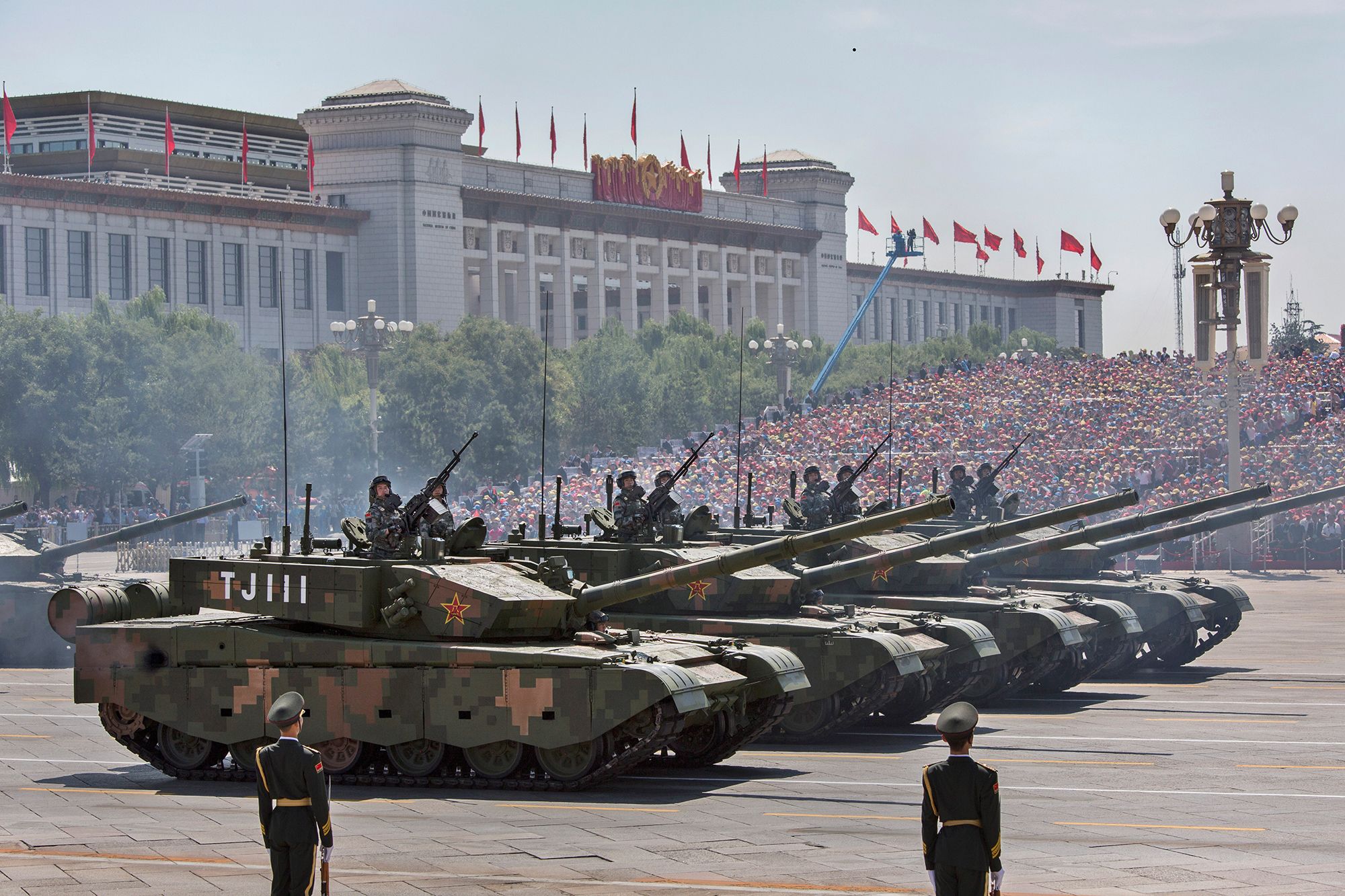
China’s push to expand its nuclear forces are part of a broader effort to modernize its military. In 2018, China spent an estimated $239.2 billion on its military – the second highest amount of any country besides the United States. Learn more.
Explore More.
The fielding of the new DF-41 has the potential to generate significant growth of China’s nuclear arsenal. The DF-41 is a road- and rail-mobile ICBM that entered service in 2019. With an estimated operational range of 12,000 – 15,000 km, the DF-41 is believed to have a greater operational range than any other missile in the world. Some estimates indicate the DF-41 could be MIRVed with up to 10 warheads. However, it may carry fewer (perhaps three warheads), and instead include penetration aids. If China doubles its arsenal by 2029, as the DIA suggests, the PLA Rocket Force may field as many as 24 DF-41 launchers with 144 warheads by 2029.
The development of the JL-3, a new SLBM, could also significantly improve China’s nuclear capabilities. The JL-3 is expected to have a range of more than 9,000 km and be MIRV-capable. Once operational, the JL-3 will likely be installed on China’s next-generation Type-096 SSBN. The increased range of the JL-3 will allow the PLA Navy’s SSBNs to launch strikes from closer to China’s shores, where they will be better protected from foreign anti-submarine warfare forces. This eventuality will significantly enhance the credibility of China’s sea-based nuclear deterrent. By 2029, China could have as many as 24 MIRVed JL-3 launchers carrying a total of 72 warheads.
As China’s nuclear capabilities improve, there is increased speculation that Beijing will adopt a more offensive nuclear posture. The 2019 DoD report on China’s military notes that Beijing may develop the capability to “launch on warning” of an incoming nuclear attack. Such a shift would require heightened readiness, advanced surveillance capabilities, and rapid response. It would also mark a watershed moment for the PLA and suggest that Beijing may move toward a more offensive nuclear force posture and abandon its NFU policy.
The likelihood of China adopting a launch on warning posture remains uncertain. During an arms control conference in October 2019, a Chinese Foreign Ministry official issued an unprecedented call for all countries to abandon the policy of preparing to launch nuclear weapons on warning of an impending nuclear strike. However, this statement came shortly after Russia announced it is assisting China with the development of a missile attack warning system – a prerequisite for maintaining a launch on warning posture.
Despite the expectation that China will increase its nuclear weapons inventory, some factors may inhibit Beijing from substantially building up its nuclear arsenal. Chief among these is China’s relatively small reserve of weapons-grade fissile material, which is needed for nuclear detonations.7 The International Panel on Fissile Materials estimates that China’s fissile material stockpile stands at 14 metric tons (MT) of highly enriched uranium and 2.9 MT of plutonium, enough to produce only a few hundred warheads. This pales in comparison to Russian and US reserves and is even smaller than the amount held by France and the United Kingdom.
Photo Credit: GREG BAKER / Staff
Keywords
Data Sources
Global Nuclear Warhead Totals, 1945-2019. View
China Power Team. "How is China modernizing its nuclear forces?" China Power. December 10, 2019. Updated December 18, 2019. Accessed January 6, 2020. https://chinapower.csis.org/china-nuclear-weapons/
Further Reading
Related Content

podcastsChina’s Nuclear Strategy and Capabilities

MilitaryDoes China have an effective sea-based nuclear deterrent?
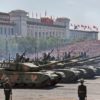
MilitaryWhat does China really spend on its military?

ChinaPower provides an in-depth understanding of the evolving nature of Chinese power relative to other countries. The project examines five interrelated categories of Chinese power: military, economics, technology, social, and international image. Through objective analysis and data visualization, ChinaPower unpacks the complexity of China’s rise.
China Power Project
Center for Strategic and International Studies
1616 Rhode Island Avenue, NW
Washington, DC 20036 Contact Us
Newsletter
Sign up for the monthly ChinaPower Newsletter, which highlights our new and updated content, featured events, and publications.
Sign Up
© 2020 by the Center for Strategic and International Studies. All rights reserved. | Privacy Policy
https://mil.news.sina.com.cn/jssd/2020-01-06/doc-iihnzahk2234300.shtml
美国智库:中国未来10年将新增320枚核弹头
美国智库:中国未来10年将新增320枚核弹头
1,488
来源:晨枫
美国智库CSIS刊登了一篇名为《How is China modernizing its nuclear forces?》的文章,揭示了美国对中国核力量的认知。
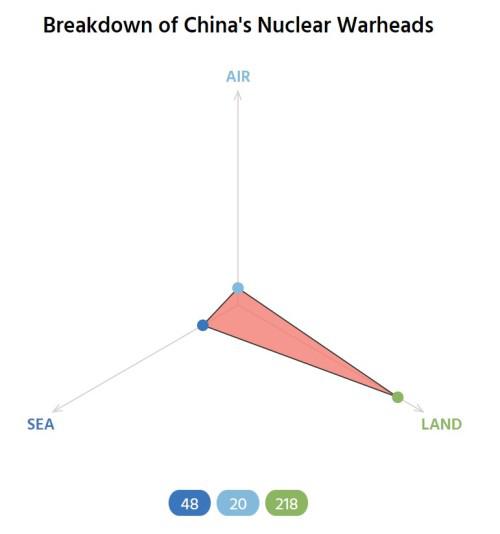
中国现有核弹头数量:48枚海基,20枚空基,218枚陆基
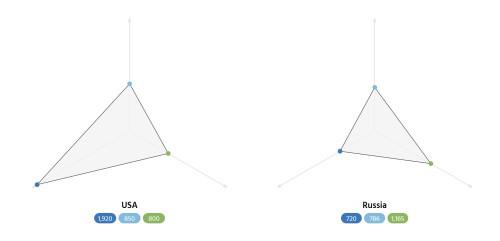
美俄现有核弹头数量:美国:1920枚海基,850枚空基,800枚陆基;俄罗斯:720枚海基,786枚空基,1165枚陆基
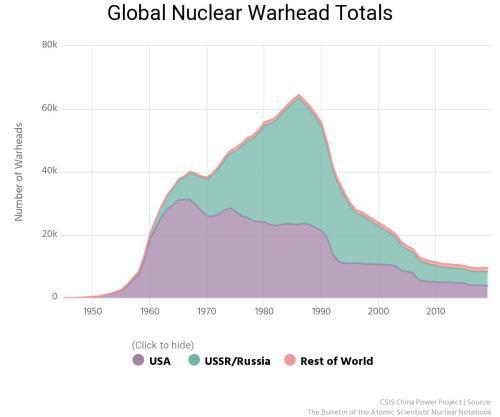
各国历年核弹头数量,在最高峰的1986年:俄罗斯40159枚,美国23317枚(最高峰在1966年,31175枚),其他国家973枚
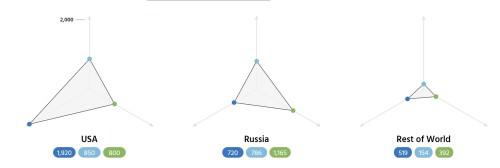
世界各国核弹头数量:美苏部分和上面重复了,其他各国:海基519枚,空基154枚,陆基392枚

其中:法国:海基240枚,空基50枚,陆基0枚;中国:海基48枚,空基20枚,陆基218枚;英国海基215枚,空基和陆基0枚;巴基斯坦:海基0枚,空基36枚,陆基114枚;印度海基16枚,空基48枚,陆基60枚
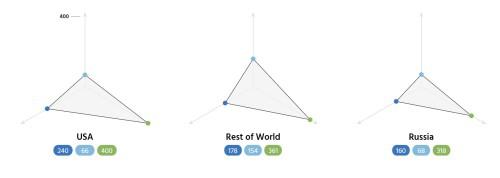
各界各国核武器发射工具数量:美国:海基240件,空基66件,陆基,400件;其他各国:海基178件,空基154件,陆基361件;俄罗斯:海基160件,空基68件,陆基318件
(以START条约的统计方法为准,海基和陆基计算导弹数量,空基计算担任和任务的飞机数量)

其中:中国:海基48件,空基20件,陆基187件;巴基斯坦:海基0件,空基36件,陆基114件;印度海基18件,空基48件,陆基60件;法国海基48件,空基50件,陆基0件;英国海基64件,空基和陆基0件
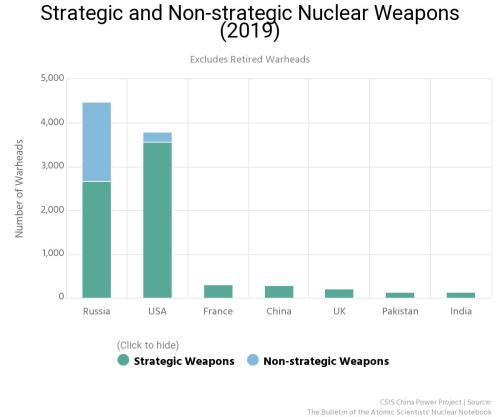
各国战略与战术核武器数量(2019年),其中战略/战术核武器:俄罗斯:2670/1820;美国:3570/230;法国:300/0;中国:290/0;英国215/0;巴基斯坦:126/24;印度:140/0
(以START条约计算方法为准,只计算实际装弹数量,库存不计)
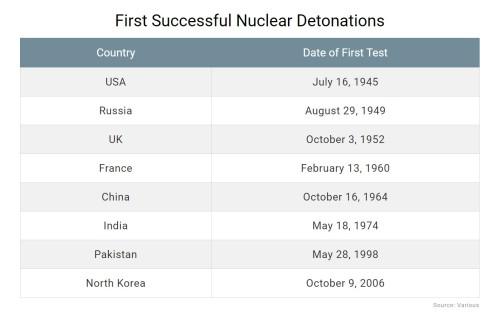
各国首次核试验时间
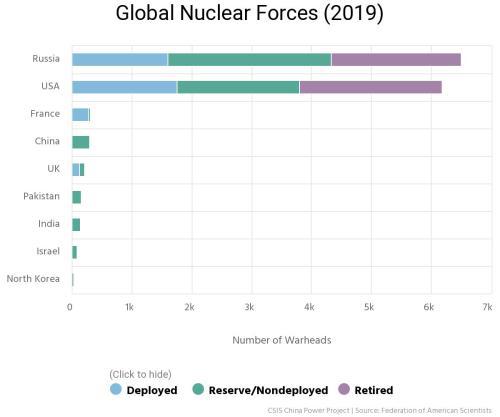
各国现有核力量中已部署/预备-未部署/退役:俄罗斯:1600/2730/2170;美国:1750/2050/2385;法国:280/20/0;中国:0/290/0;英国:120/95/0;巴基斯坦:0/150/0;印度:0/140/0;以色列:0/80/0;朝鲜:0/25/0
(这张图有点看不懂,数量和上面的弹头或者发射系统对不起来,“已部署/预备-未部署”是指第一次打击/核反击?)
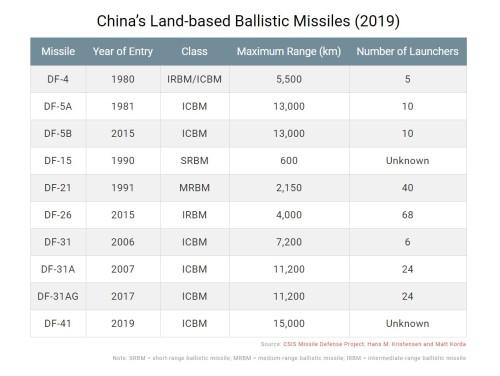
中国陆基弹道导弹基本数据(入役年代,类型,射程,数量)
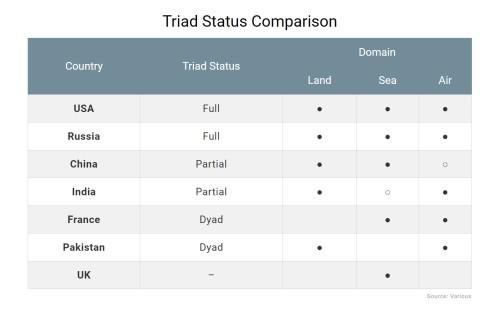
各国核三位一体情况
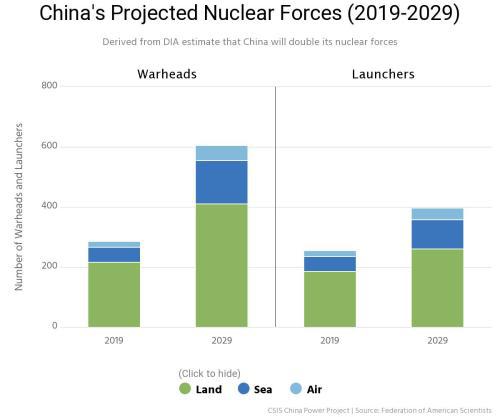
中国核力量现状与未来:
核弹头——2019年:陆基218,海基48,空基20(共286枚);2029年:陆基412,海基144,空基50(共606枚);
发射系统——2019年:陆基187,海基48,空基20;2029年:陆基262,海基96,空基40
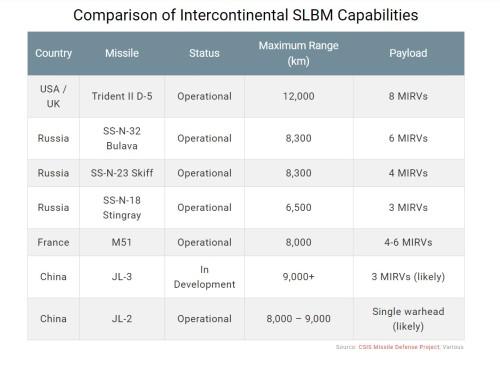
各国海基核导弹比较(型号,服役状态,射程,武器载荷)
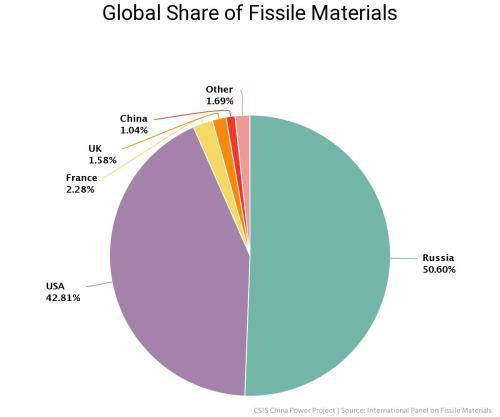
各国核材料情况,高浓度铀:俄罗斯679吨,美国574.5吨,法国30.6吨,英国21.2吨,中国14吨,其他22.7吨
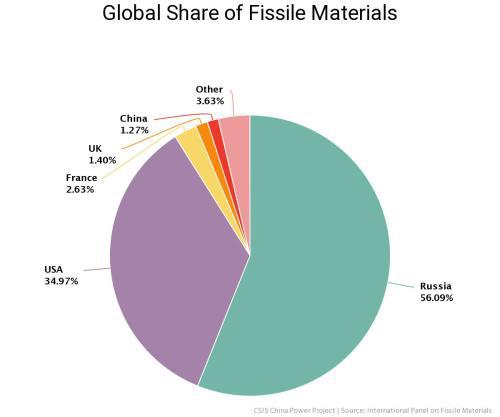
各国核材料情况(军用级钚):俄罗斯128吨,美国79.8吨,法国6吨,英国3.2吨,中国2.9吨,其他8.9吨
Skip to content
 Unpacking the complexity of China's rise
Unpacking the complexity of China's rise How is China modernizing its nuclear forces?
How is China modernizing its nuclear forces?
- Share
- Jump to
The advent of nuclear weapons fundamentally transformed the nature of warfare and strategy. Changes in policy, posture, and the number of nuclear weapons in one country can have global ramifications. China is one of only nine countries that possess nuclear weapons. Although its nuclear arsenal is small relative to those of the United States and Russia, China is currently expanding and modernizing its nuclear forces. Beijing’s primarily defensive nuclear strategy may also be revised in the coming years. Understanding the changing nature of China’s nuclear posture is critical to maintaining international peace and security.
China detonated its first atomic device on October 16, 1964. In doing so, China became the fifth country – after the United States, the Soviet Union, the United Kingdom, and France – to successfully develop a nuclear weapon.
Breakdown of China's Nuclear Warheads
- 218
- 48
- 20
Following its entrance into the atomic era, China prioritized the development of an increasingly capable arsenal composed of nuclear warheads delivered on land-based ballistic missiles. Most of China’s nuclear forces continue to be made up of land-based systems.
China also maintains a relatively small number of ballistic missiles housed on four ballistic missile submarines (SSBNs), providing China a credible sea-based nuclear deterrent.
Beijing currently possesses only a small contingent of air-based platforms capable of delivering nuclear weapons. In the coming years, China is expected to field a new strategic bomber and air-launched ballistic missiles (ALBMs).
Countries with a nuclear force structure that consists of land-based intercontinental ballistic missiles (ICBMs), submarine-launched ballistic missiles (SLBMs), and strategic bombers are said to possess a nuclear “triad.” The ability to deliver nuclear attacks from ground, sea, and air increases the survivability of a country’s nuclear forces and enhances its ability to execute a retaliatory strike. Only the US and Russia possess full, credible nuclear triads. China and India, however, are close to attaining triad status.
When China was still developing its first nuclear weapon in the early 1960s, the US and the Soviet Union were already locked into a nuclear arms race that would last for decades. By 1986, the two Cold War superpowers possessed more than 64,000 warheads combined. Global stockpiles, however, began to fall as the two sides negotiated several arms control treaties. The 1991 Strategic Arms Reduction Treaty (START), the 2002 Strategic Offensive Reduction Treaty, and the 2010 New START Treaty each led the US and Russia to significantly reduce the size of their respective nuclear arsenals.
At a time when the US and Russia have significantly reduced the size of their nuclear armaments, other countries have expanded their nuclear forces. Between 2012 and 2019, the number of Chinese warheads grew by 21 percent from 240 to 290. The stockpiles of Pakistan (from 100 to 150 warheads) and India (from 100 to 140 warheads) also increased over this period. Nonetheless, the overwhelming majority of nuclear weapons remain concentrated in the US and Russia.
The below interactive provides a breakdown of global nuclear forces in 2019. Each nuclear-armed country is depicted with a triangle showing the composition of their land, sea, and air strategic forces. Use the dropdown to toggle between warhead and launcher totals. Hover over the points of the triangles to isolate the three different types of nuclear weapons. Due to limited data, Israel and North Korea are not represented in this graphic.
View Country’s

Source: The Bulletin of the Atomic Scientists’ Nuclear Notebook
In addition to strategic nuclear weapons, several countries also possess non-strategic (or tactical) nuclear weapons. Unlike strategic nuclear weapons, which are longer-range and carry higher-yield warheads, non-strategic weapons are shorter-range systems with lower-yield warheads typically designed for attacking battlefield targets.
China’s Nuclear Strategy
For decades, Beijing has remained focused on maintaining a minimum deterrent against other nuclear-armed countries, namely the United States. China’s largely defensive strategy differs significantly from those of the US and Russia, which together possess over 87 percent of global nuclear stockpiles.
The 2006 Defense White Paper, issued by China’s State Council Information Office, provides the most authoritative description of Beijing’s nuclear strategy. The document states that China pursues a “self-defensive nuclear strategy.” It maintains that the fundamental goal of this strategy is to deter nuclear attacks against China and stop other countries from coercing China through nuclear threats.
China’s nuclear strategy centers on deterrence through “assured retaliation,” which is the ability to survive an initial attack and retaliate with nuclear strikes that inflict unacceptable damage on the attacker. In accordance with this strategy, a key feature of China’s nuclear posture is that it maintains a low alert level. Unlike US and Russian forces, which keep many of their nuclear weapons on high alert, the People’s Liberation Army (PLA) stores its warheads separately from missiles until they are paired in preparation for a retaliatory strike.
Consistent with its defensive posture, China has maintained a no first use (NFU) policy since it detonated its first nuclear weapon in 1964. China’s NFU pledge commits Beijing to only employ its nuclear weapons in response to a nuclear attack by another country. The 2006 Defense White Paper reiterates Beijing’s long-held position that China will not use or threaten to use its nuclear weapons against non-nuclear states or in “nuclear-weapon-free zones.” It also declares that China will not enter an arms race.
| First Successful Nuclear Detonations | |
|---|---|
| Country | Date of First Test |
| USA | July 16, 1945 |
| Russia | August 29, 1949 |
| UK | October 3, 1952 |
| France | February 13, 1960 |
| China | October 16, 1964 |
| India | May 18, 1974 |
| Pakistan | May 28, 1998 |
| North Korea | October 9, 2006 |
| Source: Various |
Beijing’s official NFU policy differentiates China from most other nuclear-armed states. India is the only other country to maintain an NFU policy. However, New Delhi conditions its NFU pledge. In 2003, the Indian government announced that India retains the option of a nuclear first strike “in the event of a major attack against India, or Indian forces anywhere, by biological or chemical weapons.”
Other countries do not have NFU policies. The Soviet Union, under Leonid Brezhnev, committed to an official NFU policy in 1982, but the Russian Defense Ministry announced the end of the policy in 1993.1 Moscow now holds a policy that allows for the use of nuclear weapons in response to conventional threats. The US commits to not employing nuclear weapons against non-nuclear states, but reserves the right to strike first against nuclear-armed countries to defend the US homeland and US partners and allies.
China remains firmly committed to the policy of no first use of nuclear weapons at any time and under any circumstances.
China’s 2006 Defense White Paper
While China’s official NFU policy is unconditional, many observers are skeptical that Beijing will abide by this policy during a crisis. For instance, Chinese officials have privately indicated that a conventional strike on China’s nuclear forces would provoke a nuclear response from Beijing. It remains unclear whether – and under what circumstances – China might initiate use of nuclear weapons.
China’s Nuclear Forces
According to the 2006 Defense White Paper, the PLA maintains a “lean and efficient” nuclear arsenal. This indicates that China keeps a small but high-quality nuclear arsenal with the necessary technologies and capabilities to serve as an effective deterrent. Instead of seeking parity with the US or Russia, China’s 2015 Defense White Paper notes that China seeks “nuclear capabilities at the minimum level required for maintaining its national security.”
Survivability is the key to China’s strategy of assured retaliation. For many years, China’s leaders perceived that their silo-based, liquid-fueled missiles were vulnerable to a preemptive strike. To address this concern, China undertook significant efforts to secure and modernize its nuclear forces.
During the mid-1980s, China expanded a series of underground facilities to shelter its nuclear (and conventional) weapons from enemy attack. After the US military demonstrated significant precision strike capabilities during the 1991 Persian Gulf War, China sped up work to reinforce and expand these underground facilities, which the Department of Defense (DoD) estimates now number in the thousands.
Historically, China’s nuclear deterrent has centered on its land-based intercontinental ballistic missiles. In the early 2000s, China made significant advances by fielding road- and rail-mobile ICBMs to complement its existing silo-based Dong Feng-5 (DF-5). The DF-31 was fielded in 2006 and features a maximum range of 7,200 km. An improved variant, the DF-31A, entered service in 2007 and has a range of up to 11,200 km. The mobility of these systems greatly enhances their survivability.
| China’s Land-based Ballistic Missiles (2019) | ||||
|---|---|---|---|---|
| Missile | Year of Entry | Class | Maximum Range (km) | Number of Launchers |
| DF-4 | 1980 | IRBM/ICBM | 5,500 | 5 |
| DF-5A | 1981 | ICBM | 13,000 | 10 |
| DF-5B | 2015 | ICBM | 13,000 | 10 |
| DF-15 | 1990 | SRBM | 600 | Unknown |
| DF-21 | 1991 | MRBM | 2,150 | 40 |
| DF-26 | 2015 | IRBM | 4,000 | 68 |
| DF-31 | 2006 | ICBM | 7,200 | 6 |
| DF-31A | 2007 | ICBM | 11,200 | 24 |
| DF-31AG | 2017 | ICBM | 11,200 | 24 |
| DF-41 | 2019 | ICBM | 15,000 | Unknown |
| Source: CSIS Missile Defense Project; Hans M. Kristensen and Matt Korda | ||||
| Note: SRBM = short-range ballistic missile; MRBM = medium-range ballistic missile; IRBM = intermediate-range ballistic missile |
The DF-31A compares closely to Russia’s Yars (RS-24), which is also a solid-fueled, road-mobile ICBM with a range of 10,500 km. As of 2019, Russia possessed an estimated 96 RS-24 launchers, each carrying four warheads on multiple independently targetable reentry vehicles (MIRVs). By comparison, China currently possesses roughly 24 DF-31As, each carrying a single warhead per missile.2 China and Russia remain heavily reliant on road-mobile systems. In contrast, the US maintains silo-based ICBMs.
Beijing has undertaken efforts to diversify its nuclear arsenal, which has brought China close to attaining triad status. China already possesses nuclear capabilities across land, sea, and air; however, the US Defense Intelligence Agency (DIA) states that China will not possess a “credible” nuclear triad until a strategic bomber enters service into the PLA Air Force in the future.
| Triad Status Comparison | ||||
|---|---|---|---|---|
| Country | Triad Status | Domain | ||
| Land | Sea | Air | ||
| USA | Full | ● | ● | ● |
| Russia | Full | ● | ● | ● |
| China | Partial | ● | ● | ○ |
| India | Partial | ● | ○ | ● |
| France | Dyad | ● | ● | |
| Pakistan | Dyad | ● | ● | |
| UK | – | ● | ||
| Source: Various |
The sea-based leg of China’s nuclear forces was solidified in 2015 when the PLA Navy introduced the Julang-2 (JL-2) SLBM.3 The JL-2 features a range of 8,000-9,000 km. China’s four Jin-class (Type-094) SSBNs each carry 12 JL-2s, giving the PLA Navy an estimated 48 nuclear warheads. Some sources claim that the JL-2 can be MIRVed with three to eight warheads, but it likely carries only one warhead.
Learn More"Does China have an effective sea-based nuclear deterrent?"
Although the JL-2 gives China a credible sea-based nuclear deterrent, it is less capable than the SLBMs of Russia and the US.4 Russia’s SS-N-23 Skiff, for instance, has a similar range as the JL-2, but carries four MIRVed warheads.5 The US Trident II D-5 is even more capable. It features a range of 12,000 km and can deliver a volley of eight MIRVed warheads. The UK’s nuclear arsenal is entirely sea-based and composed solely of Trident D-5 missiles armed with British warheads.
The air-based component of China’s strategic deterrent has, until recently, occupied a low priority. The PLA Air Force is currently developing a new nuclear-capable subsonic strategic stealth bomber, the Xian H-20, which in many ways will be similar to the US B-2 Spirit bomber. The H-20 is expected to enter service as early as 2025 and may have a range of up to 8,500 km. China is simultaneously developing an ALBM, which would boost the nuclear capabilities of the PLA Air Force. The DoD and the DIA judge that fielding these systems would give China a credible nuclear triad.
China’s Evolving Nuclear Capabilities
China is pursuing sweeping efforts to reform and modernize its military, including its nuclear forces. In December 2015, the Second Artillery Corps, which operated China’s land-based nuclear and conventional missile forces, was renamed the PLA Rocket Force and upgraded from an independent branch to a full military service.
In the coming years, China is expected to expand its nuclear arsenal to meet changing security conditions. DIA Director Lt. Gen. Robert P. Ashley, Jr. stated in May 2019 that China is likely to “more than double” the size of its nuclear weapons stockpile over the next decade.6 The DIA estimate is among the highest projections for China’s nuclear stockpiles.
Some analysts have questioned the DIA’s assessment, noting that the agency has a record of providing “worst-case predictions.” While it remains uncertain, it is possible that China will substantially increase the size of its nuclear arsenal by 2029 by fielding several new launchers and dramatically increasing the number of MIRVed missiles in its arsenal.
China’s efforts to expand and modernize its nuclear forces are primarily aimed at maintaining assured retaliation in the face of a shifting security environment. Other nuclear powers are similarly engaged in modernization efforts. The US military is currently updating all three legs of its aging nuclear triad. Russia is also in the process of replacing aging Soviet-era ICBMs and SLBMs, and developing next generation delivery systems like the Avangard hypersonic glide vehicle. Likewise, India currently has at least five new nuclear weapons systems under development, some of which could become operational over the next decade.
The US is also continuing to build out its ballistic missile defense programs, which Beijing considers to be the most serious threat to its nuclear deterrent. The US Ground-based Midcourse Defense system, for example, provides the US with a limited capability to defend against a small long-range ballistic missile attack. Chinese officials have also expressed concern about the Terminal High Altitude Area Defense (THAAD) system. When South Korea agreed to deploy a THAAD battery in Seoul in 2016, Beijing strongly protested and claimed that the system’s advanced radar was capable of undermining its strategic deterrent.
Beijing worries that the establishment of an advanced, multi-layered US missile defense architecture will weaken China’s strategic deterrent by diminishing its ability to deliver a retaliatory nuclear attack. To avert this outcome, China is expanding the number of weapons in its arsenal and increasing the sophistication of its delivery systems. It is also MIRVing more of its warheads. MIRVs are much harder to defend against than a single warhead, as they require missile defense systems to destroy multiple targets simultaneously. In addition to MIRVs, many of China’s missiles carry penetration aids, such as decoys and chaff, designed to boost its offensive capabilities.

China’s push to expand its nuclear forces are part of a broader effort to modernize its military. In 2018, China spent an estimated $239.2 billion on its military – the second highest amount of any country besides the United States. Learn more.
Explore More.
The fielding of the new DF-41 has the potential to generate significant growth of China’s nuclear arsenal. The DF-41 is a road- and rail-mobile ICBM that entered service in 2019. With an estimated operational range of 12,000 – 15,000 km, the DF-41 is believed to have a greater operational range than any other missile in the world. Some estimates indicate the DF-41 could be MIRVed with up to 10 warheads. However, it may carry fewer (perhaps three warheads), and instead include penetration aids. If China doubles its arsenal by 2029, as the DIA suggests, the PLA Rocket Force may field as many as 24 DF-41 launchers with 144 warheads by 2029.
The development of the JL-3, a new SLBM, could also significantly improve China’s nuclear capabilities. The JL-3 is expected to have a range of more than 9,000 km and be MIRV-capable. Once operational, the JL-3 will likely be installed on China’s next-generation Type-096 SSBN. The increased range of the JL-3 will allow the PLA Navy’s SSBNs to launch strikes from closer to China’s shores, where they will be better protected from foreign anti-submarine warfare forces. This eventuality will significantly enhance the credibility of China’s sea-based nuclear deterrent. By 2029, China could have as many as 24 MIRVed JL-3 launchers carrying a total of 72 warheads.
| Comparison of Intercontinental SLBM Capabilities | ||||
|---|---|---|---|---|
| Country | Missile | Status | Maximum Range (km) | Payload |
| USA / UK | Trident II D-5 | Operational | 12,000 | 8 MIRVs |
| Russia | SS-N-32 Bulava | Operational | 8,300 | 6 MIRVs |
| Russia | SS-N-23 Skiff | Operational | 8,300 | 4 MIRVs |
| Russia | SS-N-18 Stingray | Operational | 6,500 | 3 MIRVs |
| France | M51 | Operational | 8,000 | 4-6 MIRVs |
| China | JL-3 | In Development | 9,000+ | 3 MIRVs (likely) |
| China | JL-2 | Operational | 8,000 – 9,000 | Single warhead (likely) |
| Source: CSIS Missile Defense Project; Various |
As China’s nuclear capabilities improve, there is increased speculation that Beijing will adopt a more offensive nuclear posture. The 2019 DoD report on China’s military notes that Beijing may develop the capability to “launch on warning” of an incoming nuclear attack. Such a shift would require heightened readiness, advanced surveillance capabilities, and rapid response. It would also mark a watershed moment for the PLA and suggest that Beijing may move toward a more offensive nuclear force posture and abandon its NFU policy.
The likelihood of China adopting a launch on warning posture remains uncertain. During an arms control conference in October 2019, a Chinese Foreign Ministry official issued an unprecedented call for all countries to abandon the policy of preparing to launch nuclear weapons on warning of an impending nuclear strike. However, this statement came shortly after Russia announced it is assisting China with the development of a missile attack warning system – a prerequisite for maintaining a launch on warning posture.
Despite the expectation that China will increase its nuclear weapons inventory, some factors may inhibit Beijing from substantially building up its nuclear arsenal. Chief among these is China’s relatively small reserve of weapons-grade fissile material, which is needed for nuclear detonations.7 The International Panel on Fissile Materials estimates that China’s fissile material stockpile stands at 14 metric tons (MT) of highly enriched uranium and 2.9 MT of plutonium, enough to produce only a few hundred warheads. This pales in comparison to Russian and US reserves and is even smaller than the amount held by France and the United Kingdom.
Photo Credit: GREG BAKER / Staff
Keywords
Data Sources
Global Nuclear Warhead Totals, 1945-2019. View
China Power Team. "How is China modernizing its nuclear forces?" China Power. December 10, 2019. Updated December 18, 2019. Accessed January 6, 2020. https://chinapower.csis.org/china-nuclear-weapons/
Further Reading
- “China Military Power: Modernizing a Force to Fight and Win,”US Defense Intelligence Agency, January 15, 2019.
- Hans M. Kristensen and Matt Korda, “Chinese nuclear forces, 2019,” Bulletin of the Atomic Scientists, vol. 75, no. 4, 171-178.
- Fiona S. Cunningham and M. Taylor Fravel, “Assuring Assured Retaliation: China’s Nuclear Posture and U.S.-China Strategic Stability,” International Security, vol. 40, no. 2 (Fall 2015), pp. 7–50.
- “Military and Security Developments Involving the People’s Republic of China 2019,” US Department of Defense, May 2, 2019.
- “Nuclear Posture Review,” US Department of Defense, February 2018.
Related Content

podcastsChina’s Nuclear Strategy and Capabilities

MilitaryDoes China have an effective sea-based nuclear deterrent?

MilitaryWhat does China really spend on its military?

ChinaPower provides an in-depth understanding of the evolving nature of Chinese power relative to other countries. The project examines five interrelated categories of Chinese power: military, economics, technology, social, and international image. Through objective analysis and data visualization, ChinaPower unpacks the complexity of China’s rise.
China Power Project
Center for Strategic and International Studies
1616 Rhode Island Avenue, NW
Washington, DC 20036 Contact Us
Newsletter
Sign up for the monthly ChinaPower Newsletter, which highlights our new and updated content, featured events, and publications.
Sign Up
© 2020 by the Center for Strategic and International Studies. All rights reserved. | Privacy Policy
https://mil.news.sina.com.cn/jssd/2020-01-06/doc-iihnzahk2234300.shtml
美国智库:中国未来10年将新增320枚核弹头
美国智库:中国未来10年将新增320枚核弹头
1,488
来源:晨枫
美国智库CSIS刊登了一篇名为《How is China modernizing its nuclear forces?》的文章,揭示了美国对中国核力量的认知。

中国现有核弹头数量:48枚海基,20枚空基,218枚陆基

美俄现有核弹头数量:美国:1920枚海基,850枚空基,800枚陆基;俄罗斯:720枚海基,786枚空基,1165枚陆基

各国历年核弹头数量,在最高峰的1986年:俄罗斯40159枚,美国23317枚(最高峰在1966年,31175枚),其他国家973枚

世界各国核弹头数量:美苏部分和上面重复了,其他各国:海基519枚,空基154枚,陆基392枚

其中:法国:海基240枚,空基50枚,陆基0枚;中国:海基48枚,空基20枚,陆基218枚;英国海基215枚,空基和陆基0枚;巴基斯坦:海基0枚,空基36枚,陆基114枚;印度海基16枚,空基48枚,陆基60枚

各界各国核武器发射工具数量:美国:海基240件,空基66件,陆基,400件;其他各国:海基178件,空基154件,陆基361件;俄罗斯:海基160件,空基68件,陆基318件
(以START条约的统计方法为准,海基和陆基计算导弹数量,空基计算担任和任务的飞机数量)

其中:中国:海基48件,空基20件,陆基187件;巴基斯坦:海基0件,空基36件,陆基114件;印度海基18件,空基48件,陆基60件;法国海基48件,空基50件,陆基0件;英国海基64件,空基和陆基0件

各国战略与战术核武器数量(2019年),其中战略/战术核武器:俄罗斯:2670/1820;美国:3570/230;法国:300/0;中国:290/0;英国215/0;巴基斯坦:126/24;印度:140/0
(以START条约计算方法为准,只计算实际装弹数量,库存不计)

各国首次核试验时间

各国现有核力量中已部署/预备-未部署/退役:俄罗斯:1600/2730/2170;美国:1750/2050/2385;法国:280/20/0;中国:0/290/0;英国:120/95/0;巴基斯坦:0/150/0;印度:0/140/0;以色列:0/80/0;朝鲜:0/25/0
(这张图有点看不懂,数量和上面的弹头或者发射系统对不起来,“已部署/预备-未部署”是指第一次打击/核反击?)

中国陆基弹道导弹基本数据(入役年代,类型,射程,数量)

各国核三位一体情况

中国核力量现状与未来:
核弹头——2019年:陆基218,海基48,空基20(共286枚);2029年:陆基412,海基144,空基50(共606枚);
发射系统——2019年:陆基187,海基48,空基20;2029年:陆基262,海基96,空基40

各国海基核导弹比较(型号,服役状态,射程,武器载荷)

各国核材料情况,高浓度铀:俄罗斯679吨,美国574.5吨,法国30.6吨,英国21.2吨,中国14吨,其他22.7吨

各国核材料情况(军用级钚):俄罗斯128吨,美国79.8吨,法国6吨,英国3.2吨,中国2.9吨,其他8.9吨
